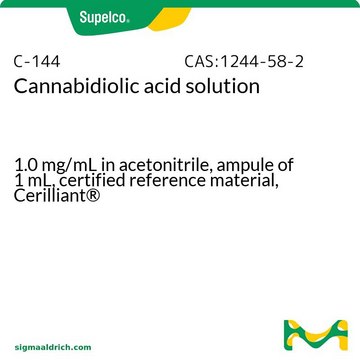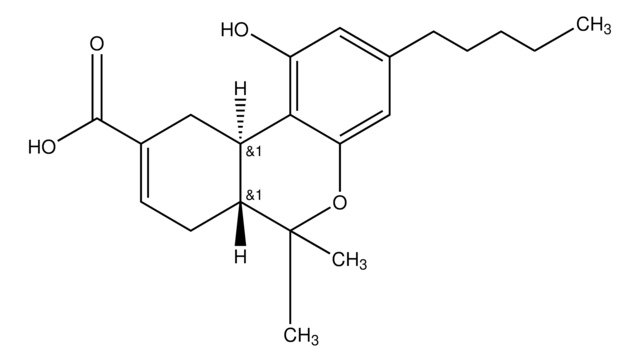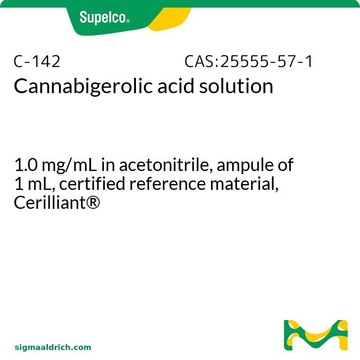Wichtige Dokumente
T-032
(−)-Δ8-THC -Lösung
1.0 mg/mL in methanol, ampule of 1 mL, certified reference material, Cerilliant®
About This Item
Empfohlene Produkte
Qualität
certified reference material
Qualitätsniveau
Form
liquid
Leistungsmerkmale
Snap-N-Spike®/Snap-N-Shoot®
Verpackung
ampule of 1 mL
Hersteller/Markenname
Cerilliant®
drug control
Narcotic Licence Schedule D (Switzerland); psicótropo (Spain); Decreto Lei 15/93: Tabela IIB (Portugal)
Konzentration
1.0 mg/mL in methanol
Methode(n)
gas chromatography (GC): suitable
liquid chromatography (LC): suitable
Anwendung(en)
cannabis testing
cannabis testing
Format
single component solution
Lagertemp.
−20°C
SMILES String
O1C(C2C(CC(=CC2)C)c3c1cc(cc3O)CCCCC)(C)C
InChI
1S/C21H30O2/c1-5-6-7-8-15-12-18(22)20-16-11-14(2)9-10-17(16)21(3,4)23-19(20)13-15/h9,12-13,16-17,22H,5-8,10-11H2,1-4H3
InChIKey
HCAWPGARWVBULJ-UHFFFAOYSA-N
Allgemeine Beschreibung
Anwendung
- Multianalyse von 11 Cannabinoiden in Biomasse und Extrakten von verschiedenen Cannabisvarianten mittels HPLC-UV-Verfahren gemäß der dreiteiligen Richtlinie zur Validierung von Analyseverfahren des International Council for Harmonisation (ICH)
- Trennung und Bewertung von 13 Cannabinoiden aus verschiedenen Cannabis-Produkten unter Verwendung einer isokratischen Hochleistungsflüssigkeitschromatografie (HPLC) in Kombination mit einem Diodenarraydetektor (DAD)
- Gaschromatografie-Massenspektrometrie (GC-MS)-Analyse von zehn Hauptcannabinoiden aus Hanfblüten nach ihrer Silylierung und Veresterung für die Derivatisierung
- Quantifizierung von Cannabidiol und Δ9-Tetrahydrocannabinol zusätzlich zu der Identifizierung von geringfügigen Cannabinoiden in Humanplasmaproben mittels Ultrahochleistungsflüssigkeitschromatografie (UHPLC) in Kombination mit Triple-Quadrupol-Massenspektrometrie nach einer Flüssig-Flüssig-Extraktion
- QuEChERS-basierte Extraktion von 15 Cannabinoiden aus 20 Lebensmittelproben nach ihrer Quantifizierung durch Flüssigchromatografie-Tandem-Massenspektrometrie (LC-MS/MS)
Leistungsmerkmale und Vorteile
- Vollständig charakterisiert unter ISO/IEC 17025 und ISO 17034-Akkreditierung
- Wird mit einem umfassenden Analysenzertifikat (CoA) geliefert, das Daten zu Stabilität, Homogenität, Genauigkeit der Konzentration, Messunsicherheit und Rückverfolgbarkeit enthält
- Durch Echtzeit-Stabilitätsstudien streng geprüft, um Genauigkeit und Haltbarkeit sicherzustellen
- Mittels qualifizierten Präzisionswaagen gravimetrisch hergestellt, um minimale Messunsicherheit sicherzustellen
- Für lange Haltbarkeit unter Argon in Ampullen schmelzversiegelt
- Wird in einem praktischen, DEA-befreiten Format bereitgestellt, um die Laboreffizienz zu steigern
Rechtliche Hinweise
Ähnliches Produkt
Signalwort
Danger
H-Sätze
Gefahreneinstufungen
Acute Tox. 3 Dermal - Acute Tox. 3 Inhalation - Acute Tox. 3 Oral - Flam. Liq. 2 - STOT SE 1
Zielorgane
Eyes
Lagerklassenschlüssel
3 - Flammable liquids
WGK
WGK 2
Flammpunkt (°F)
51.8 °F - closed cup
Flammpunkt (°C)
11.0 °C - closed cup
Zulassungslistungen
Zulassungslistungen werden hauptsächlich für chemische Produkte erstellt. Für nicht-chemische Produkte können hier nur begrenzte Angaben gemacht werden. Kein Eintrag bedeutet, dass keine der Komponenten gelistet ist. Es liegt in der Verantwortung des Benutzers, die sichere und legale Verwendung des Produkts zu gewährleisten.
EU REACH Annex XVII (Restriction List)
Hier finden Sie alle aktuellen Versionen:
Analysenzertifikate (COA)
It looks like we've run into a problem, but you can still download Certificates of Analysis from our Dokumente section.
Wenn Sie Hilfe benötigen, wenden Sie sich bitte an Kundensupport
Besitzen Sie dieses Produkt bereits?
In der Dokumentenbibliothek finden Sie die Dokumentation zu den Produkten, die Sie kürzlich erworben haben.
Artikel
As the popularity of cannabis-infused products increases, there is a growing need to characterize the type and content of the cannabinoids found in the product. This application demonstrates the ability of the Ascentis Express C18 column to baseline resolve 14 structurally-similar cannabinoids, in under seven minutes, with excellent peak shape.
The cannabinoids found in the Cannabis plant commonly referred to as marijuana, have grown in popularity for treating a variety of ailments from arthritis, glaucoma, and chronic pain to malnutrition, multiple sclerosis, and cancer.
Tetrahydrocannabinolic acid A solution, 1.0 mg/mL in acetonitrile, ampule of 1 mL, certified reference material.
Protokolle
Potency testing in marijuana-infused edibles is an important problem that analytical labs are facing due to the complexity of the involved matrices. Concentration of active ingredients in these edibles can range from a few parts per million to 3.5 parts per thousand. This application demonstrates the extraction and HPLC-UV analysis of the active compounds.
As the popularity of cannabis-infused products increases, there is a growing need to characterize the type and content of the cannabinoids found in the product. This application demonstrates the ability of the Ascentis Express C18 column to baseline resolve 14 structurally-similar cannabinoids, in under seven minutes, with excellent peak shape.
Rapid potency testing of marijuana-infused edibles using LC/MS on a biphenyl stationary phase detected eleven cannabinoids.
Tetrahydrocannabinolic acid A solution, 1.0 mg/mL in acetonitrile, ampule of 1 mL, certified reference material; Cannabichromenic Acid (CBCA) solution, 1.0 mg/mL in acetonitrile, certified reference material, ampule of 1 mL
Global Trade Item Number
| SKU | GTIN |
|---|---|
| T-032-1ML | 4061837328978 |
Unser Team von Wissenschaftlern verfügt über Erfahrung in allen Forschungsbereichen einschließlich Life Science, Materialwissenschaften, chemischer Synthese, Chromatographie, Analytik und vielen mehr..
Setzen Sie sich mit dem technischen Dienst in Verbindung.









